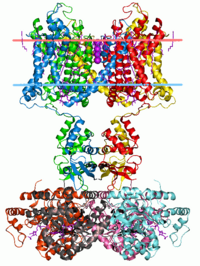
Photo from wikipedia
The hERG channel is a voltage-gated potassium channel found in cardiomyocytes that contributes to the repolarization of the cell membrane following the cardiac action potential, an important step in the… Click to show full abstract
The hERG channel is a voltage-gated potassium channel found in cardiomyocytes that contributes to the repolarization of the cell membrane following the cardiac action potential, an important step in the regulation of the cardiac cycle. The lipids surrounding K+ channels have been shown to play a key role in their regulation, with anionic lipids shown to alter gating properties. In this study, we investigate how anionic lipids interact with the pore helix of hERG and compare the results with those from Kv1.5, which possesses a pore helix more typical of K+ channels. Circular dichroism studies of the pore helix secondary structure reveal that the presence of the anionic lipid DMPS within the bilayer results in a slight unfolding of the pore helices from both hERG and Kv1.5, albeit to a lesser extent for Kv1.5. In the presence of anionic lipids, the two pore helices exhibit significantly different interactions with the lipid bilayer. We demonstrate that the pore helix from hERG causes significant perturbation to the order in lipid bicelles, which contrasts with only small changes observed for Kv1.5. These observations suggest that the atypical sequence of the pore helix of hERG may play a key role in determining how anionic lipids influence its gating.
Journal Title: European Biophysics Journal
Year Published: 2017
Link to full text (if available)
Share on Social Media: Sign Up to like & get
recommendations!